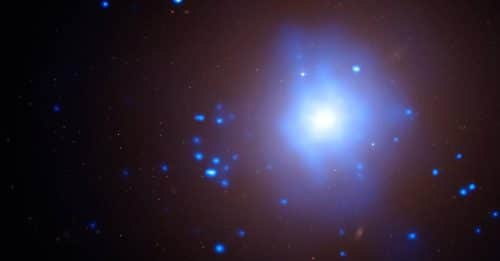The scientists of the Weizmann Institute and their research partners have shown that this is not a star explosion - a supernova - but a rare phenomenon: a giant black hole, located in the heart of a young galaxy and spinning at relative speed, "swallows" a star that has come too close to it.

When astronomers and astrophysicists see a bright flash of light in the night sky, their initial working assumption is that it is a supernova - a star that has exploded and thrown most of its material into space. There are several models that describe various causes and processes that may cause supernova explosions, starting with stars - which have a certain minimum mass - that use up their nuclear fuel, throw their mantle into space, and collapse in on themselves creating a black hole, and ending with a double star where one of the "sons" The couple" (white dwarf) pulls its partner to it and crushes it into it. Therefore, on June 14, 2015, when a flash of light was discovered in a distant galaxy, quite a few scientists believed that it was a supernova.
However, in this event an extremely strong flash of light was observed, twice as strong as the one considered the strongest until then, and as a result the question arose as to the type of supernova that caused it. Moreover, apart from the intensity of the flash, several other "strange" characteristics stood out in this event. Thus, for example, the temperature in the flash region did not decrease gradually, as happens in supernovae, but it decreased, then increased again, and remained more or less constant for a long time. On top of that, the event did not take place in a young, "blue" galaxy (the type of galaxies where supernovae usually occur), but in a "red" galaxy, in which most of the stars are already quite old, and are not destined to explode.
These phenomena aroused the curiosity of the post-doctoral researcher Giorgios Laludas and Prof. Avishai Gal-Yam, from the Department of Particle Physics and Astrophysics at the Weizmann Institute of Science. Together with their colleagues from the institute's staff, Dr. Paul Variswick, Dr. Ofer Yaron, Dr. Steve Schultz and Ira Bar, as well as research partners from universities around the world, they observed the event, documented and measured it. This is how it turned out that the spectrum of the event changed, and this gave rise to the hypothesis that this is a relatively rare phenomenon, which so far has only been observed about ten times: the destruction of a star as a result of gravitational surges from the giant black hole at the heart of the galaxy. This assumption was strengthened by the fact that the flash event took place right in the center of the galaxy. In addition, the non-decreasing temperature phenomenon was known from the few events of stellar destruction due to black hole gravitational surges observed in the past.
In fact, even as an event of a black hole's gravitational surge, it was a rare and unique event, since, for such a flash to occur, two conditions must be met: a star moving close to the event threshold of the black hole will cross it and be swallowed by the black hole, and at the same time, the resulting light will succeed "escape" from the massive gravitational force of the black hole. These two conditions can exist at the same time if the black hole in the center of the galaxy is very large, and it is spinning on its own around its axis - at a relativistic speed (close to the speed of light). Indeed, the measurements and findings of the institute's scientists and their research partners showed that the tremendous flash of light was caused by the gravitational surges of a very massive black hole, which is spinning at a relative speed. These findings were recently published in the scientific journal "Nature Astronomy".
#Science_Numbers
The mass of the black hole that caused the tremendous flash of light is 100 million times greater than the mass of our sun. For comparison, the mass of the black hole at the center of the Milky Way galaxy, where the Earth is located, is 4 million times the mass of our Sun.
More of the topic in Hayadan:

One response
"flare"….
Does not matter…
My question: when did the event take place? After all, light takes time to cross space. How long did it take for the light to travel the distance to the telescope, so that it would be possible to estimate where the "flash" came from...
When did the event happen, briefly?